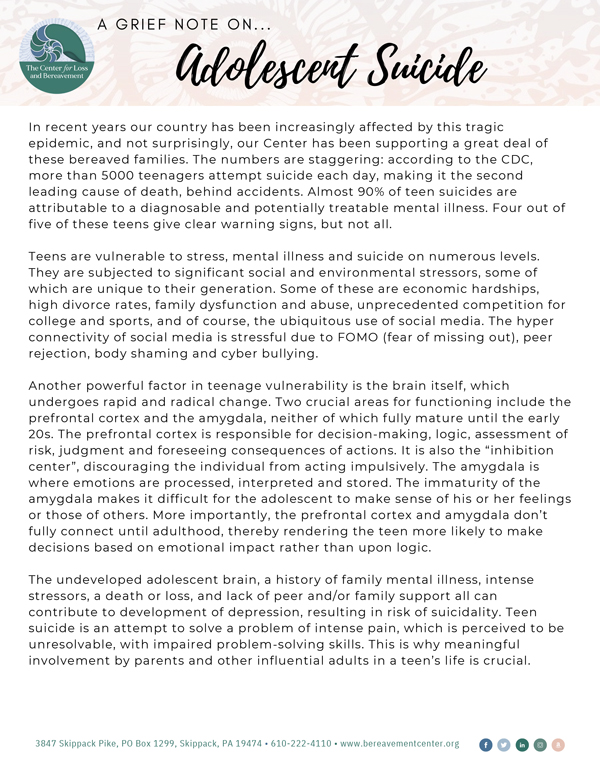CLB Grief Notes
A Grief Note On…
Adolescent Suicide
In recent years our country has been increasingly affected by this tragic epidemic, and not surprisingly, our Center has been supporting a great deal of these bereaved families. The numbers are staggering: according to the CDC, more than 5000 teenagers attempt suicide each day, making it the second leading cause of death, behind accidents. Almost 90% of teen suicides are attributable to a diagnosable and potentially treatable mental illness. Four out of five of these teens give clear warning signs, but not all.
Teens are vulnerable to stress, mental illness and suicide on numerous levels. They are subjected to significant social and environmental stressors, some of which are unique to their generation. Some of these are economic hardships, high divorce rates, family dysfunction and abuse, unprecedented competition for college and sports, and of course, the ubiquitous use of social media. The hyper connectivity of social media is stressful due to FOMO (fear of missing out), peer rejection, body shaming and cyber bullying.
Another powerful factor in teenage vulnerability is the brain itself, which undergoes rapid and radical change. Two crucial areas for functioning include the prefrontal cortex and the amygdala, neither of which fully mature until the early 20s. The prefrontal cortex is responsible for decision-making, logic, assessment of risk, judgment and foreseeing consequences of actions. It is also the “inhibition center”, discouraging the individual from acting impulsively. The amygdala is where emotions are processed, interpreted and stored. The immaturity of the amygdala makes it difficult for the adolescent to make sense of his or her feelings or those of others. More importantly, the prefrontal cortex and amygdala don’t fully connect until adulthood, thereby rendering the teen more likely to make decisions based on emotional impact rather than upon logic.
The undeveloped adolescent brain, a history of family mental illness, intense stressors, a death or loss, and lack of peer and/or family support all can contribute to development of depression, resulting in risk of suicidality. Teen suicide is an attempt to solve a problem of intense pain, which is perceived to be unresolvable, with impaired problem-solving skills. This is why meaningful involvement by parents and other influential adults in a teen’s life is crucial.
Much ado has resulted from the Netflix series, “13 Reasons Why”, which has also been occasionally accessed by teens outside of their parent’s awareness. The show graphically depicts the suicide of a 17-year-old after chronicling her audio messages describing why she did it. There has been strong debate about the impact of the show. School officials, psychologists, and suicide prevention experts are concerned that teens, especially those with existing mood disorders are susceptible to contagion, i.e. “copycat” suicide attempts. Research shows that this phenomenon is real. Many are also concerned with the harmful perpetuation of blame and guilt on survivors of loved ones who have died by suicide. However, others argue that the show enhances prevention by stimulating honest conversations about suicide, essentially “teachable moments”, and raises awareness on the importance of addressing bullying, sexual assault, and systems of critical response.
The debate will likely continue, but parents are advised to monitor their children’s access to this show as well as social media usage. Parents can take a proactive role in initiating conversations with their teens even if they are not exhibiting overt signs of depression. Adults can encourage teens to view life from a “metaperspective”. That is, to realize that “There’s life after that exam, post, party, or that photo, or that boy. High school is not forever. There’s always going to be more”.
Sometimes despite parent’s best efforts and optimal conditions, teens complete suicide anyway. Occasionally, teens appear functional and well-adjusted, but are silently struggling, and impulsively succumb to a stressor or trigger. Other teens are diagnosed with a mental illness and have undergone grueling and extensive trials of medications and psychiatric hospitalizations. Regardless of the best medical care and family support, there are unfortunately still high numbers of teens who fall to the all-consuming wish for relief through suicide. In these cases, nobody is to blame, and those surviving are most vulnerable in dealing with their own pain.
These deaths result in grief that is extremely painful, complicated, and stigmatized for parents and surviving loved ones. This is profoundly life altering and requires months and years to reconcile. It is known in the field of suicide prevention that post-vention IS prevention, since having a loved one die and especially die by suicide actually increases one’s likelihood of becoming suicidal. Our center exists to help such survivors and is dedicated to being part of the Suicide Prevention Task Force of Montgomery County. If you or a loved one has been affected by a death by suicide, please reach out – help is available and there are people who can help hold your pain with you.
Join Our
Mailing List
Donate
Today
Request
Information

Affiliations
• NACG
• CBEM Changemaker
• ADEC
• Charity Navigator
Quick Links
About Us
Individual & Family Grief Counseling
Volunteer
News
Grief Support Resources
Contact
Ph: 610-222-4110
Fax: 610-222-4116
3847 Skippack Pike
P.O. Box 1299
Skippack, PA 19474
Support The Center For
Loss and Bereavement
